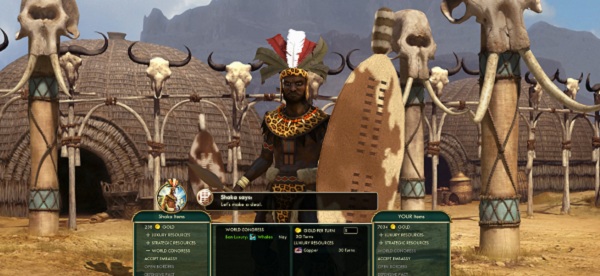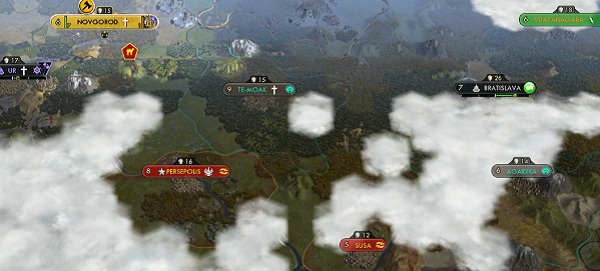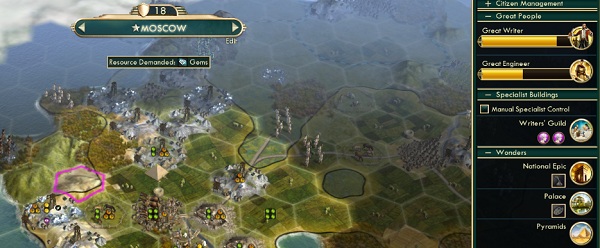Wot I Think: Civ V - Brave New World
How many goodly features are there here
I've founded religions, spied on my neighbours and sent a spaceship in search of a new home on a distant star. The promise of a Brave New World was enough to bring me crashing back down to Earth though, and I've been making new friends, meeting old enemies and creating great works of art. This latest expansion takes on the greatest challenge of all - injecting some meaningful activity into Civilization's end-game. I've spent a week uncovering its charms and chores, and here's wot I think.
Montezuma ate my camels.
The early game hasn’t changed a great deal, at least in principal, but there are new leaders to encounter and select, and even before I’d discovered trade, the first new Back of the Box Bullet Point feature, one addition had reared its ugly head.
Oh, hello, Shaka, it’s been a while. I remember when you discovered gunpowder back in the original Civilization and then shot all of my warriors while they were still wearing pants made of rocks and waving clubs that were made of pants.
Shaka is one of my oldest enemies and it’s good/horrible to see him back. Like the time you encounter a wheezing banker in a nightclub and realise that he’s the evolved form of a red-faced kid who used to bully you at school, it’s tempting to hope for an ounce of maturity. No such luck. An hour later he’ll be chortling, lager-breathed, about ‘the good old days’. By the time the bouncers push you into the takeaway reek of the night, the imprint of his shiny shoes will be etched onto your face.
Same deal with Shaka. There isn’t even time to reminisce about the old days before he’s asking me to back away from his borders, all the while churning out unsustainable armies and crippling himself with debt just to intimidate me. Maybe he doesn’t recognise me. I’m the socially progressive Casimir III of Poland now and the last time we met I think I was a Roman. Either way, he seems determined to fuck with me, hemming me in at one end of the continent we’re sharing.
My scouts and warriors find plenty of good land as we approach the classical era. Unfortunately, Genghis Khan and Montezuma have spilled their seeds all over it and angry spearmen have sprouted. I’m surrounded by expansionist, militaristic assholes and there are catapults rumbling toward my capital city. It’s the Aztecs. I think they’re coming for me even though we’re on friendly terms. The AI's actions are still baffling at times and not always intentionally. I tend to wait for leaders to approach me rather than initiating contact because otherwise I have to deal with more rejections than a Raggy Doll.
Thankfully, the catapults trundle past Warsaw, heading to the borders of a City State, which they bombard and swiftly conquer.
Two thousand years in and I’m surrounded by Aztec cities. This leads me to my first terrifying realisation – Genghis Khan, Montezuma and Shaka are immortal. My civilization is doomed to exist on a landmass occupied by three everliving bastards. Over the centuries, they will remain belligerent and, in Montezuma’s case, terrifyingly erratic. The only way to change their ways is to destroy every trace of their existence. Like Terminators, they will not stop, ever, until I am extremely pissed off and decide to nuke them.
Because Montezuma has managed to surround my cities, by accident rather than design, it’s much easier to open trade routes with him than anyone else. Trade is the first new feature encountered in Brave New World, chronologically. A set number of trade routes are available, increasing when specific technologies have been researched, and each needs a caravan to wander back and forth along it. They can be captured, which provides a small bounty to the aggressor, but their range isn’t huge to begin with, so they’re unlikely to encounter a great deal of enemy territory. Fuck barbarians though, obviously.
The value of a route depends on distance, unique goods at each destination and various other factors. It’s give and take though, importantly, so while the originator receives greater benefits, the target state or civ also receives gold/research. Religious pressure also travels in both directions – for me, trade was the Trojan horse by means of which the newly founded Cult of the Looking Glass spread its influence across borders.
I don’t know if the straw that broke the Aztecs was the subtle dissemination of religious ideas that mostly concerned the tract ‘Tithes and the Absolute Importance of Paying Them’, but one day my caravan of camels rode into Aztec territory and never came back. The immortal Blood God, Montezuma, has declared war on me and eaten my camels. It shouldn’t surprise me. He refers to human sacrifice almost every time we sit down to chat, like an awkward grandparent sharing his views about ALL Germans over Christmas dinner.
The dilemma of a trade network - vulnerable to the whims of those near the route who may hijack it and even vulnerable to the whims of the partner. When that partner is unpredictable Uncle Monty, caravanning is far from a stable source of income.
Tourism is the second great change and it’s far more significant, providing an entirely new resource and victory condition rather than methods to bolster existing resources. As anyone who has ever booked an all-inclusive beach resort holiday can tell you, tourism is the offensive side of culture. If your tourism output overtakes a country’s own cultural output, they are in awe of your civ. If every remaining opponent is in that state, it’s game over. You’ve won.
As with the rest of the additions, tourism cleverly slots into place with existing features rather than replacing them and it’s hard to imagine the game without it after playing for a while. Essentially, there are buildings with slots for great works of art/writing/music and the appropriate great person can create a masterpiece to fill those slots.
Purely from a flavour perspective, the fact that the specific work created is drawn from the correct historical period and briefly shown makes me happy. The same is true of the artifacts discovered during archaeological digs, which make every historical battle site and ruined city/encampment a potential treasure trove by the mid-game. Dig them up with the new archaeologist unit and they too can be used to generate tourism, although other civs may be irritated if you dredge up the history of their failures and put it on display.
That’s the early game and mid-game covered. The end-game is where the real problems have always been though – generations of Civ players pressing the ‘end turn’ button, drool threading from their lower lip, the completion of a construction queue as thrilling as a thousand orgasms. Brave New World’s solution is to layer activities. As well as managing a military, if that’s your thing, it’s necessary to keep an eye on the battle between tourism and culture. One of my complaints regarding Civ in general but Civ V more specifically is that by the mid-game I often feel like I’ve set up a machine and am now the maintenance man. Brave New World avoids this somewhat, with trade routes requiring attention every 30 turns, at which point they can be renewed or replaced.
And, of course, there’s the final addition: The World Congress. The first player who has both invented the printing press and met every other civ forms the congress, which is a sort of diplomatic hub, United Nations and squabble centre. Motions are brought forward, ranging from a ban on nuclear weapons to trade embargoes on specific resources or nations, and over the next few turns players lobby for votes and influence. City States can be handy here, giving them some much-needed late-game significance, and the oft-neglected diplomatic screens are home to a flurry of activity.
It’s an excellent device for strengthening a position or screwing over an enemy, complicated by the rise of ideologies in the modern era, which provide new social policies to uncover, and can realign the entire diplomatic makeup of the world. The AI involves itself in all of this well enough to provide interest, although it’ll never pass a Turing Test. On the whole, the AI is stronger, attacking and retreating with some awareness of the tide of battle. The flags by which it operates are still too obvious, destroying the illusion of playing a thinking thing rather than a set of variables, but it’s better than before, which is admirable considering the increased complexity of the game.
When I judged Gods and Kings, I considered it a decent addition but nothing too convince those who hadn’t liked the base game. Brave New World might just convince some of those willing to give it a chance. This is by far the best Civ V has ever been, particularly in multiplayer where the congress shines. Technical issues remain, mostly on larger maps in the late game when the wait between turns can be exasperating, but the fact that I stay there, until the morning’s light, clicking, waiting, enjoying the occasional organisation or ordnance related orgasm.
Civ V is still a game about winning rather than about being, but the paths to victory are more complex and diverse than before. Take Venice, for example, which cannot build settlers and must rely on its influence to spread and succeed. More than ever, the civilizations feel specialised, which can make the future seem pre-determined to an extent, but it’s rare for twenty turns to pass without some form of surprise. And that, amazingly, is more than enough.
Civ V: Brave New World is available now.






